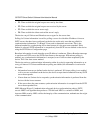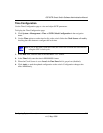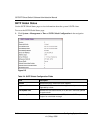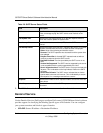
GS700TR Smart Switch Software Administration Manual
Configuring System Information 2-11
v1.0, May, 2008
2. Click Refresh to refresh the page with the most current data from the switch.
Last Attempt Status Specifies the status of the last SNTP request or unsolicited message for
both unicast and broadcast modes. If no message has been received
from a server, a status of Other is displayed. These values are
appropriate for all operational modes:
• Other: None of the following enumeration values.
• Success: The SNTP operation was successful and the system time
was updated.
• Request Timed Out: A directed SNTP request timed out without
receiving a response from the SNTP server.
• Bad Date Encoded: The time provided by the SNTP server is not
valid.
• Version Not Supported: The SNTP version supported by the server
is not compatible with the version supported by the client.
• Server Unsynchronized: The SNTP server is not synchronized with
its peers. This is indicated via the 'leap indicator' field on the SNTP
message.
• Server Kiss Of Death: The SNTP server indicated that no further
queries were to be sent to this server. This is indicated by a stratum
field equal to 0 in a message received from a server.
Server IP Address Specifies the IP address of the server for the last received valid packet.
If no message has been received from any server, an empty string is
shown.
Address Type Specifies the address type of the SNTP Server address for the last
received valid packet.
Server Stratum Specifies the claimed stratum of the server for the last received valid
packet.
Reference Clock Id Specifies the reference clock identifier of the server for the last received
valid packet.
Server Mode Specifies the mode of the server for the last received valid packet.
Unicast Sever Max Entries Specifies the maximum number of unicast server entries that can be
configured on this client.
Unicast Server Current
Entries
Specifies the number of current valid unicast server entries configured
for this client.
Broadcast Count Specifies the number of unsolicited broadcast SNTP messages that
have been received and processed by the SNTP client since last
reboot.
Table 2-4. SNTP Global Configuration Fields (continued)
Field Description


















